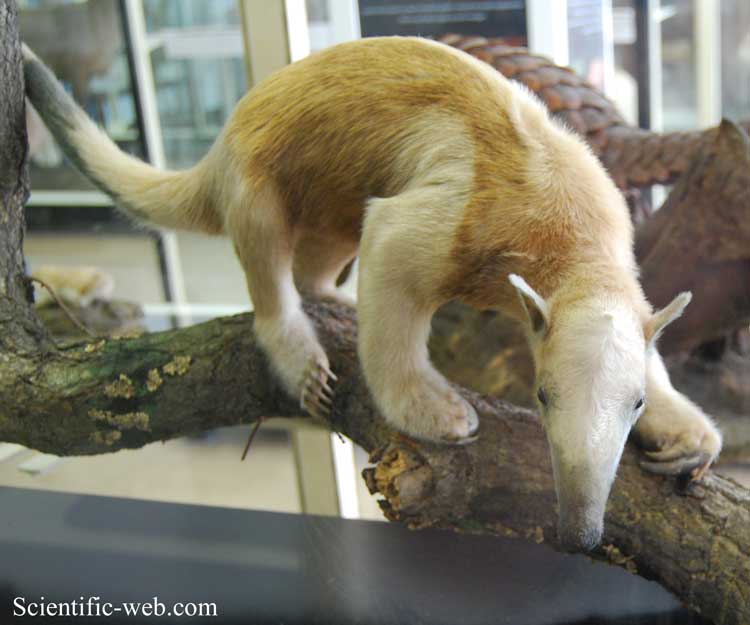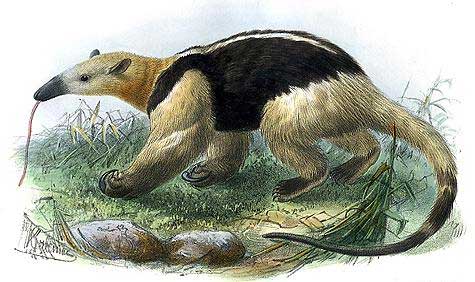
Tamandua tetradactyla, Photo: Michael Lahanas
Superregnum: Eukaryota
Regnum: Animalia
Subregnum: Eumetazoa
Cladus: Bilateria
Cladus: Nephrozoa
Superphylum: Deuterostomia
Phylum: Chordata
Cladus: Craniata
Subphylum: Vertebrata
Infraphylum: Gnathostomata
Superclassis: Tetrapoda
Cladus: Reptiliomorpha
Cladus: Amniota
Cladus: Synapsida
Cladus: Eupelycosauria
Cladus: Sphenacodontia
Cladus: Sphenacodontoidea
OrdoTherapsida
Cladus: Theriodontia
Subordo: Cynodontia
Cladus: Mammaliaformes
Classis: Mammalia
Subclassis: Trechnotheria
Infraclassis: Zatheria
Supercohort: Theria
Cohort: Eutheria
Cohort: Placentalia
Superordo: Xenarthra
Ordo: Pilosa
Subordo: Vermilingua
Familia: Myrmecophagidae
Genus: Tamandua
Species: Tamandua tetradactyla
Subspecies (4): T. t. nigra – T. t. quichua – T. t. straminea – T. t. tetradactyla
Name
Tamandua tetradactyla (Linnaeus, 1758)
Original combination: Myrmecophaga tetradactyla
Type locality: "America meridionali", Brazil, Pernambuco, Recife (Thomas, 1911)
Synonyms
Myrmecophaga tamandua G. Cuvier, 1798
Tamandua longicaudata (Turner, 1853)
Tamandua longicauda Vesey-FitzGerald, 1936
Tamandua longicauda Rode, 1937
Tamandua longicaudata var. nigra Beaux, 1908
Tamandua longicaudata mexianae Cabrera, 1958
Tamandua tetradactyla Linnaeus, 1758

Tamandua tetradactyla (*)
References
Linnaeus, C. 1758. Systema Naturae per regna tria naturæ, secundum classes, ordines, genera, species, cum characteribus, differentiis, synonymis, locis, Tomus I. Editio decima, reformata. Holmiæ: impensis direct. Laurentii Salvii. i–ii, 1–824 pp DOI: 10.5962/bhl.title.542: 35. Reference page.
Tamandua tetradactyla in Mammal Species of the World.
Wilson, Don E. & Reeder, DeeAnn M. (Editors) 2005. Mammal Species of the World – A Taxonomic and Geographic Reference. Third edition. ISBN 0-8018-8221-4.
IUCN: Tamandua tetradactyla (Linnaeus, 1758) (Least Concern)
Vernacular names
català: Tamàndua meridional
dansk: Tamandua
Deutsch: Südlicher Tamandua
English: Southern Tamandua
Esperanto: Suda tamanduo
español: Oso mielero
euskara: Tamandua tetradactyla
suomi: Tamandua
français: Tamandua tetradactyla
magyar: Dolmányos hangyász
italiano: Tamandua tetradactyla
日本語: ミナミコアリクイ
한국어: 남부작은개미핥기
lietuvių: Mažoji skruzdėda
Nederlands: Zuidelijke boommiereneter
polski: tamandua południowa, mrówkojad czteropalczasty
português: tamanduá-mirim
Runa Simi: Manchunka
русский: Четырёхпалый муравьед
svenska: Sydlig tamandua
Türkçe: Küçük karıncayiyen
中文: 小食蚁兽
The southern tamandua (Tamandua tetradactyla), also called the collared anteater or lesser anteater, is a species of anteater from South America and the island of Trinidad in the Caribbean. It is a solitary animal found in many habitats, from mature to highly disturbed secondary forests and arid savannas. It feeds on ants, termites, and bees. Its very strong foreclaws can be used to break insect nests or to defend itself.
Distribution and habitat
The southern tamandua is found in Trinidad and throughout South America from Venezuela to northern Argentina, southern Brazil, and Uruguay at elevations up to 1,600 m (5,200 ft). It inhabits both wet and dry forests, including tropical rainforest, savanna, and thorn scrub.[4] It seems to be most common in habitats near streams and rivers, especially those thick with vines and epiphytes (presumably because its prey is common in these areas).
The oldest fossil tamanduas date from the Pleistocene of South America, although genetic evidence suggests they may have diverged from their closest relative, the giant anteater, in the late Miocene, 12.9 million years ago.[5]
Subspecies
The four recognised subspecies of Tamandua tetradactyla are:
T. t. tetradactyla (Linnaeus, 1758): southern and eastern Brazil, Uruguay
T. t. nigra (Geoffroy, 1803): northern Brazil, Colombia, Venezuela, Trinidad, the Guianas
T. t. quichua (Thomas, 1927): Peru, Ecuador, extreme western Brazil
T. t. straminea (Cope, 1889): southern Brazil, Paraguay, Bolivia, Argentina
Physical description
Skull
Tamandua by C. Wendt after Gustav Mützel, for Brehms Tierleben, 1887
The southern tamandua is a medium-sized anteater, though it can vary considerably in size based on environmental conditions. It has a head and body length ranging from 34 to 88 cm (13 to 35 in), and a prehensile tail 37 to 67 cm (15 to 26 in) long. Adults weigh from 1.5 to 8.4 kg (3.3 to 18.5 lb), with no significant difference in size between males and females.[4][6] Like their close relative, the northern tamandua, they have four-clawed digits on the forefeet and five on the hind feet and walk on the outer surfaces of their forefeet to avoid puncturing their palms with their sharp claws. The underside and the tip of the tail are hairless. The snout is long and decurved with an opening only as wide as the diameter of a stick, from which the tongue is protruded. Although some differences in the shape of the skull are seen, they can most easily be distinguished from the northern tamandua by their slightly longer ears, which average around 5 cm (2.0 in) instead of 4 cm (1.6 in), as in the northern species.[4]
The individual and geographic variation observed in the southern tamandua have made the taxonomic description of these animals a difficult task. Animals from the southeastern part of the range are "strongly vested", meaning they have black markings from shoulder to rump; the black patch widens near the shoulders and encircles the forelimbs. The rest of the body can be blonde, tan, or brown. Animals from northern Brazil and Venezuela to west of the Andes are solid blonde, brown, or black, or are only lightly vested. Individuals from Trinidad are almost always solid blonde.
Reproduction
Females are polyestrous; mating generally takes place in the fall. The estrous cycle will last approximately about 42 days. Gestation ranges from 130 to 190 days.[4] The female gives birth to one offspring per year.[7] At birth, the young anteater does not resemble its parents; its coat varies from white to black. It rides on the mother's back for several months up to a year and is sometimes deposited on a safe branch while the mother forages.
Behavior
The tamandua is mainly nocturnal but is occasionally active during the day. The animals nest in hollow tree trunks or in the burrows of other animals, such as armadillos. They are solitary, occupying home ranges that average from 100 to 375 ha (250 to 930 acres), depending on the local environment.[4]
They may communicate when aggravated by hissing and releasing an unpleasant scent from their anal glands. They spend much of their time foraging arboreally; a study in various habitats in Venezuela showed this anteater spends 13 to 64% of its time in trees. The southern tamandua is quite clumsy on the ground and ambles along, incapable of the gallop its relative, the giant anteater, can achieve.
The southern tamandua uses its powerful forearms in self-defense. If it is threatened in a tree it grasps a branch with its hindfeet and tail, leaving its arms and long, curved claws free for combat. If attacked on the ground, this anteater backs up against a rock or a tree and grabs the opponent with its forearms. In the rainforest, the southern tamandua is surrounded during the day by a cloud of flies and mosquitoes and is often seen wiping these insects from its eyes. This animal has small eyes and poor vision, but its large, upright ears indicate that hearing is an important sense.
The southern tamandua is a host of the acanthocephalan intestinal parasites Gigantorhynchus echinodiscus, Gigantorhynchus lopezneyrai, and Gigantorhynchus ungriai.[8]
Diet
Southern tamanduas eat ants and termites in roughly equal proportions, although they may also eat a small quantity of fruit. They locate their food by scent, and prey on a wide range of species, including army ants, carpenter ants, and Nasutitermes.[4] They avoid eating ants armed with strong chemical defenses, such as leafcutter ants. Tamanduas are also thought[by whom?] to eat honey and bees and in captivity, have been known to eat fruit and meat. Anteaters extract their prey by using their extremely strong fore limbs to rip open nests and their elongated snouts and rounded tongues (up to 40 cm (16 in) in length) to lick up the insects.
Although it has the same diet as the giant anteater, both animals are able to live alongside one another, perhaps because the southern tamandua is able to reach nests in trees, while its larger relative cannot.[4]
Conservation
The southern tamandua is listed as CITES Appendix II in southeastern Brazil. Although widespread, they are uncommon. They are killed by hunters, who claim the tamanduas kill dogs. They are also killed for the thick tendons in their tails, from which rope is made. Tamanduas are sometimes used by Amazonian Indians to rid their homes of ants and termites.
Citations
Gardner, A.L. (2005). "Order Pilosa". In Wilson, D.E.; Reeder, D.M (eds.). Mammal Species of the World: A Taxonomic and Geographic Reference (3rd ed.). Johns Hopkins University Press. p. 103. ISBN 978-0-8018-8221-0. OCLC 62265494.
Miranda, F.; Fallabrino, A.; Arteaga, M.; Tirira, D.G.; Meritt, D.A.; Superina, M. (2014). "Tamandua tetradactyla". IUCN Red List of Threatened Species. 2014: e.T21350A47442916. doi:10.2305/IUCN.UK.2014-1.RLTS.T21350A47442916.en. Retrieved 12 November 2021.
Linnæus, Carl (1758). Systema naturæ per regna tria naturæ, secundum classes, ordines, genera, species, cum characteribus, differentiis, synonymis, locis. Tomus I (in Latin) (10th ed.). Holmiæ: Laurentius Salvius. p. 35. Retrieved 23 November 2012.
Hayssen, V. (2011). "Tamandua tetradactyla (Pilosa: Myrmecophagidae)". Mammalian Species. 43 (1): 64–74. doi:10.1644/875.1.
Barros, M.C.; et al. (2003). "Phylogenetic analysis of 16S mitochondrial DNA data in sloths and anteaters". Genetics and Molecular Biology. 26 (1): 5–11. doi:10.1590/S1415-47572003000100002.
Burnie D and Wilson DE (Eds.), Animal: The Definitive Visual Guide to the World's Wildlife. DK Adult (2005), ISBN 0789477645
Bernegossi, Agda Maria (February 8, 2018). "Evaluation of collared anteaters (Tamandua tetradactyla) presented in a wildlife health reference center of Sao Paulo state, Brazil" (PDF).
Nascimento Gomes, Ana Paula; Cesário, Clarice Silva; Olifiers, Natalie; de Cassia Bianchi, Rita; Maldonado, Arnaldo; Vilela, Roberto do Val (December 2019). "New morphological and genetic data of Gigantorhynchus echinodiscus (Diesing, 1851) (Acanthocephala: Archiacanthocephala) in the giant anteater Myrmecophaga tridactyla Linnaeus, 1758 (Pilosa: Myrmecophagidae)". International Journal for Parasitology: Parasites and Wildlife. 10: 281–288. doi:10.1016/j.ijppaw.2019.09.008. PMC 6906829. PMID 31867208.
General sources
Emmons, Louise H.; Feer, François (1997-09-02). Neotropical Rainforest Mammals: A Field Guide (2nd ed.). Chicago: University of Chicago Press. pp. 39–41. ISBN 978-0-226-20721-6. OCLC 44179508.
Gorog, A. 1999. "Tamandua tetradactyla" from Animal Diversity Web.
Retrieved from "http://en.wikipedia.org/"
All text is available under the terms of the GNU Free Documentation License

